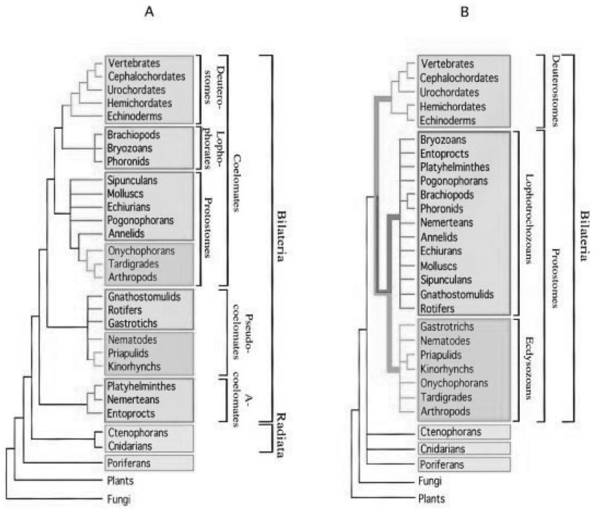Use Figure 30.3 and the following information when answering the next question.
In a review paper published in 2000, Adoutte et al. examined some animal phylogenies generated by comparing the ribosoma rRNA) of animals from many different phyla. They then integrated these independently created phylogenies into one phylog best fit all the data.
Figure 30.4 compares a traditional phylogeny based on morphological characteristics A) to the new molecular- based phylog described by Adoutte et al. B) .
Note that platyhelminthes, nemerteans, and entoprocts, which do not have coeloms and are classified as acoelomates in the morphological phylogeny, are reclassified as lophotrochozoans in the molecular phylogeny. Similarly, groups classified as pseudocoelomates in the morphological phylogeny are reclassified as either lophotrochozoans or ecdysozoans in the molecula phylogeny; other lophotrochozoans and ecdysozoans have coeloms.
A. Adoutte, G. Balavoine, N. Lartillot, O. Lespinet, B. Prud'homme, and R. de Rosa. 2000. The new animal phylogeny. Figure 30.3
Figure 30.3
-What does this reclassification based on molecular data imply about the evolution of acoelomates, pseudocoelomates, and coelomates?
A) Pseudocoelomates can be seen as an intermediate stage between acoelomate and coelomate development.
B) Some pseudocoelomates and acoelomates have evolved from coelomates.
C) Although acoelomates and pseudocoelomates evolved only once, coelomates evolved multiple times in different lineages.
D) Only the animals that evolved earliest are acoelomates.
Correct Answer:
Verified
Q10: Which of the following is not a
Q11: Q12: Which of the following statements concerning animal Q13: From the information provided in the figure Q14: Which tissue type, or organ, is not Q16: In examining an unknown animal species during Q17: While looking at some seawater through your Q18: Which one of the following objects most Q19: If you think of the tube- within- Q20: Which of the following combinations of embryonic![]()
Unlock this Answer For Free Now!
View this answer and more for free by performing one of the following actions

Scan the QR code to install the App and get 2 free unlocks

Unlock quizzes for free by uploading documents